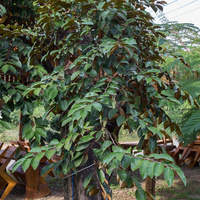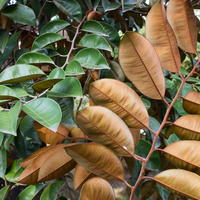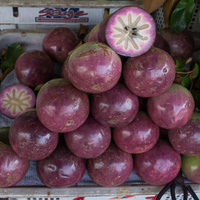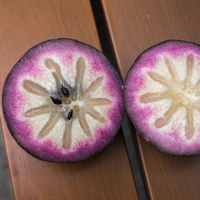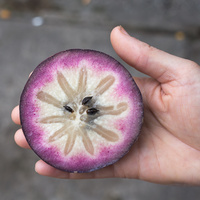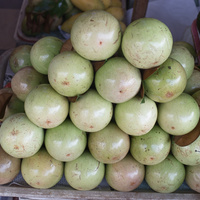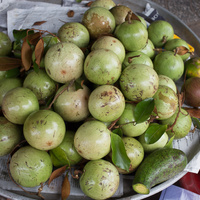Common name: Star Apple
Other common names: Star Plum
Description
Star Apple is a fruit-bearing tree originating in the Caribbean, its natural range extending across the chain of islands from Jamaica, through the Cayman Islands, Cuba and Hispaniola, to Puerto Rico.
It is a medium-sized tree and may reach heights of up to 30 m (100 ft) in natural forest habitats, though it is more commonly 15 to 20 m (50 to 65 ft) tall. On open sites, it develops a short trunk supporting a densely leafy, rounded crown of wide-spreading branches that droop at the ends, creating a weeping appearance. The bark is dark brown, rough and fissured.
Leaves are oval to elliptical, dark lacquered green on top and copper-brown underneath, their contrasting colouration adding visual interest to the tree. They remain on the tree where the dry season is short but fall to the ground where it is long and pronounced.
Flowers are tiny, purplish or greenish, and bisexual, having female and male parts. Flowering appears to be associated with decreasing day length that starts in late summer and continues into late autumn or early winter.
The fruit ripen around three to four months after fruit set, usually from winter to late spring or early summer in parts of its native range. They are round, about the size of a baseball or larger and come in smooth, purple- or green-skinned varieties. A star-shaped pattern is revealed when cut in half crosswise, leading to the name 'Star Apple' being applied to the fruit and tree. The seed are oval, largish, and glossy dark brown to near black.
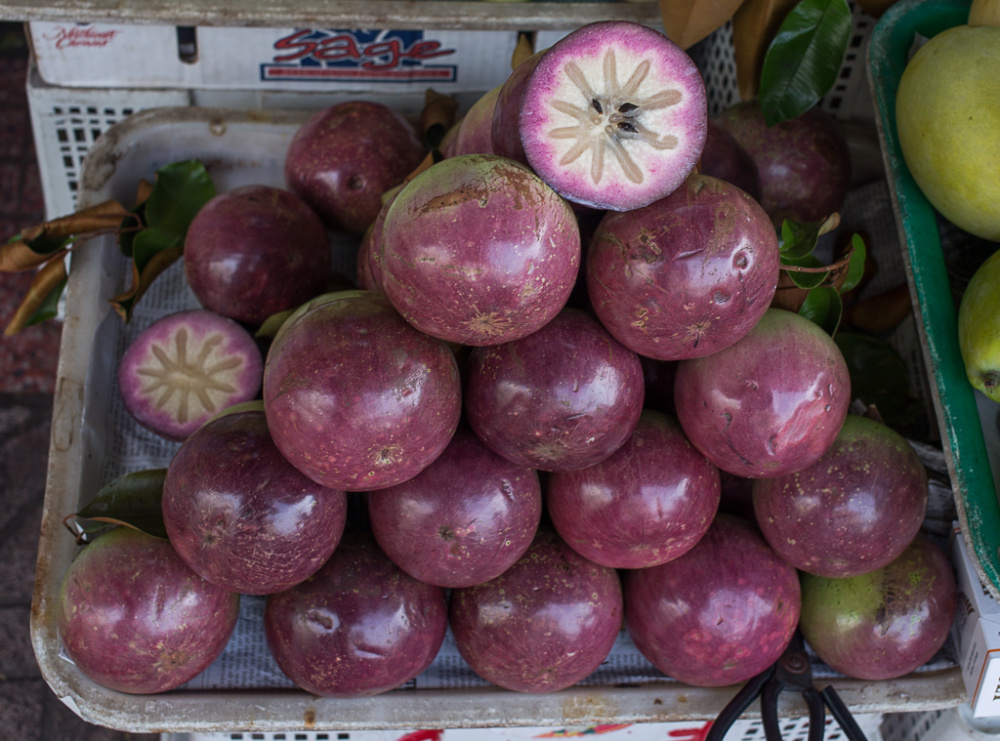
Star Apples for sale (Ho Chi Minh, Vietnam)
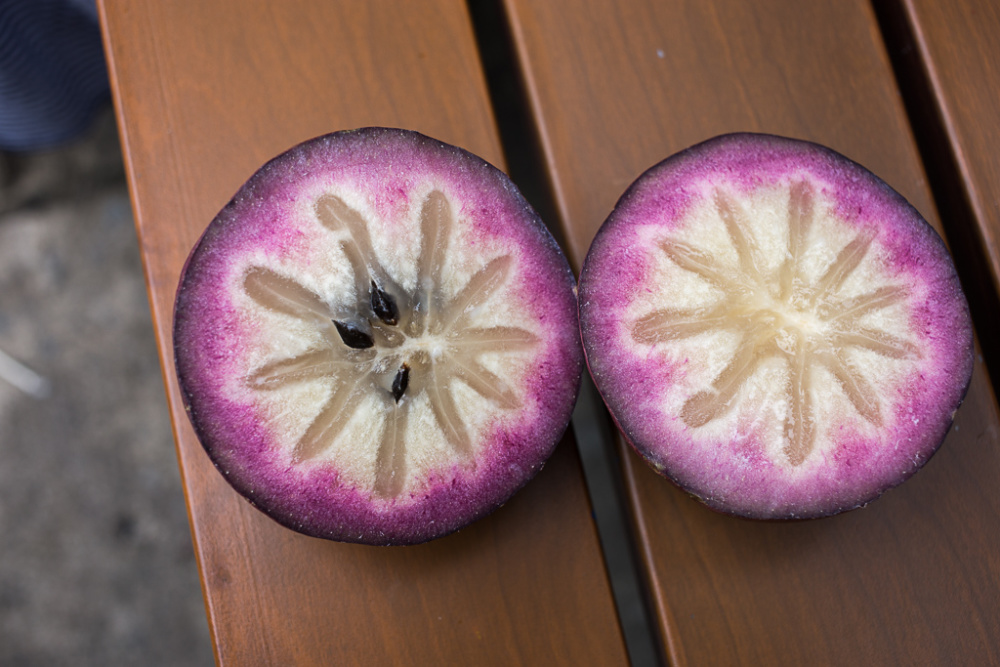
Star Apple cut in half
Use
The tree is cultivated primarily for its fruit, which are mostly eaten fresh out-of-hand and occasionally in fruit salads. They are usually cut in half, and the soft, sweet, jelly-like pulp scooped out with a spoon. Care is taken to avoid any pulp close to the rind, which has sticky latex, especially in fruit that have not fully ripened. As they do not continue to ripen after being harvested, the fruit are best left on the tree until fully ripe.
The leaves, with their contrasting colouration, add ornamental interest to gardens, and their dense arrangement provides welcome shade from the hot afternoon sun.
Star Apple trees produce a medium-weight wood, averaging out at around 700 kg per cubic meter (44 lbs per cubic ft), with low natural resistance to decay. This puts it in the non-durable hardwood class, limiting its suitability for outdoor or in-ground construction work. When available, it is used for turnery and occasionally for making furniture and cabinets.
Climate
Star Apple grows and fruits naturally in moderately humid subtropical and tropical climates, generally frost-free areas with annual lows of 15 to 25°C, annual highs of 26 to 35°C, annual rainfall of 900 to 3000 mm and a winter dry season of 3 to 6 months.
Although Star Apple trees also grow well in wetter climates with no dry season, flowering is usually poor due to fungal attack, resulting in low fruit production. As well, trees may fail to produce flavoursome fruit in areas where the average low of the warmest month is below 20°C (68°F).
Growing
New plants are usually started from seed, which remain viable for up to six months and germinate readily. However, seedling trees may take up to ten years to produce fruit, so vegetative propagation is preferred. Cuttings and air-layering (circumposing) methods are the most commonly practised and the trees start to flower and bear fruit when around three to five years old.
Mature trees in South Florida produce up to 68 kg (150 lbs) of fruit in a season but this may be low compared to regions with warmer, tropical climates.
Performs best on free-draining loam, sandy-loam and loamy-sand soils of a moderately acid to alkaline nature, generally with a pH of 5.0 to 8.0, and on sites with full to partial sun exposure.
Problem features
Star Apple is listed as a weed in at least one reference publication but there does not appear to be any record of it anywhere as a serious weed, despite its widespread cultivation throughout the tropics.
Where it grows
References
Books
-
Adams, C. D. 1972, Flowering plants of Jamaica, University of the West Indies, Mona, Greater Kingston
-
Allen, B. M. 1967, Malayan fruits : an introduction to the cultivated species, Donald Moore Press, Singapore
-
Chudnoff, M. 1984, Tropical timbers of the world, Forest Service, U.S. Department of Agriculture (USDA), Washington, D.C.
-
Gargiullo, M. B & Magnuson, B. L. & Kimball, Larry D. 2008, A field guide to plants of Costa Rica, Oxford University Press, Oxford
-
Janick, J., & Paull, R. E. 2008, The encyclopedia of fruit & nuts, CABI Publishing, Wallingford, Oxfordshire
-
Jensen, M. 1999, Trees commonly cultivated in Southeast Asia : an illustrated field guide, 2nd ed., Food and Agricultural Organisation of the United Nations (FAO) Regional Office for Asia and the Pacific (RAP), Bangkok
-
Little, E. L. et al. 1964 and 1974, Common trees of Puerto Rico and the Virgin Islands (2 volumes), Forest Service, U.S. Department of Agriculture (USDA), Washington D.C.
-
Macmillan, H. F. 1943, Tropical planting and gardening : with special reference to Ceylon, 5th ed, Macmillan Publishing, London
-
Martin, F. M., et al. 1987, Perennial edible fruits of the tropics : an inventory, U.S. Dept. of Agriculture (USDA), Agricultural Research Service, U.S. Government Printing Office (GPO), Washington, D.C.
-
Morton, J. F. & Dowling, C. F. 1987, Fruits of warm climates, Creative Resources Systems, Winterville, North Carolina
-
Page, P. E. 1984, Tropical tree fruits for Australia, Queensland Department of Primary Industries (QLD DPI), Brisbane
-
Queensland Department of Primary Industries and Fisheries (QLD DPI) 2008, Queensland tropical fruit : the healthy flavours of North Queensland, Brisbane
-
Randall, R. P. 2002, A global compendium of weeds, R.G. and F.J. Richardson Press, Melbourne
-
Randall, R. P. 2007, The introduced flora of Australia and its weed status, Cooperative Research Centre for Australian Weed Management, Glen Osmond, South Australia
-
Scheffer, T. C & Morrell, J. J. 1998, Natural durability of wood : a worldwide checklist of species, Forest Research Laboratory, Oregon State University, Corvallis, Oregon
-
Schubert, T. H. 1979, Trees for urban use in Puerto Rico and the Virgin Islands. U.S. Department of Agriculture, Forest Service, Southern Forest Experiment Station, New Orleans
-
Wilder, G. P. 1911, Fruits of the Hawaiian Islands rev. ed, Honolulu: The Hawaiian gazette co. ltd.
Articles, Journals, Reports and Working Papers
-
Subhadrabandhu, S. 2001, Under-utilized tropical fruits of Thailand, Food and Agriculture Organisation of the United Nations (FAO), Regional Office for Asia and the Pacific (RAPA), Bangkok
-
Walkar, Tad, et al. Dispersal modes of woody species from the northern Western Ghats, India. Tropical Ecology 53.1 (2012).
-
Watson, B.J., & Moncur, M. 1985, Guideline criteria for determining survival, commercial and best mean minimum July temperatures for various tropical fruit in Australia (Southern Hemisphere), Department of Primary Industries Queensland (DPI QLD), Wet Tropics Regional Publication, Queensland
